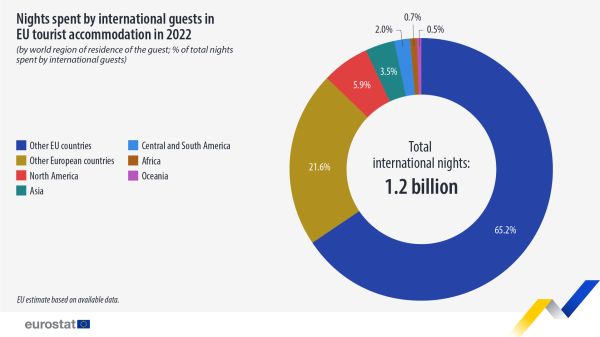Tourism statistics - annual results for the accommodation sector
Data extracted in October 2023.
Planned article update: 25 October 2024.
Highlights
Nights spent in EU tourist accommodation in 2022: up by 50% compared with 2021, reaching 96% of the pre-Covid-19 levels.
In 2022, German tourists accounted for nearly one in four nights spent by international guests in EU tourist accommodation.
This publication focuses on developments in the tourist accommodation sector in the European Union.
Following continuous growth from 2009 until 2019, tourism in the EU was among the most affected sectors by the Covid-19 pandemic in 2020. The number of nights spent in EU tourist accommodation establishments in 2020 fell to half compared with 2019. 2021 showed clear signs of recovery, reaching nearly two-thirds of 2019 levels. The upward trend continued in 2022, when it reached 96 %, while short term indicators for monthly data showed that the number of nights spent during the first six months of 2023 exceeded the pre-pandemic level for the first six months of 2019 (see Tourism statistics - nights spent at tourist accommodation establishments).
Full article
Nights spent in EU tourist accommodation in 2022: up by 50 % compared with 2021, reaching 96 % of the pre-Covid-19 levels.
Over the period 2009-2019, the number of nights spent in EU tourist accommodation establishments grew by 40 %. In particular, there were significant increases in the number of nights spent by international guests (+53 %) while the number of nights spent by residents during domestic trips increased by 30 %. In 2020, tourism was among the most affected sectors by the Covid-19 pandemic with a sharp drop of 51 % in the number of nights spent compared with 2019. 2021 showed clear signs of recovery, with 29 % more nights spent in EU tourist accommodation compared with 2020, while the upward trend continued in 2022, with 50 % more nights spent compared with 2021 (see Figure 1).
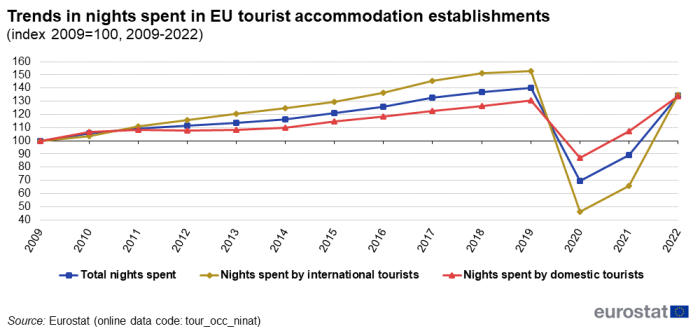
Source: Eurostat (tour_occ_ninat)
With almost 2.8 billion nights spent in 2022 (see Table 1), EU tourism reached 96 % of pre-pandemic 2019 levels. Spain, France, Italy and Germany each recorded more than 400 million nights spent in 2022. Jointly, these four countries accounted for more than six out of ten nights spent in the EU in 2022.
Looking at the distribution by type of accommodation, hotels and similar accommodation were clearly the most popular (61.6 %), followed by holiday and other short-stay accommodation such as rented apartments (24.0 %) and camping grounds, recreational vehicle parks and trailer parks (14.5 %). However, there were significant regional differences: in Bulgaria, Cyprus and Malta hotels covered more than 90 % of the entire market for rented accommodation; more than half of the tourism nights in Croatia were spent in holiday and other short-stay accommodation, while the highest share for campsites was observed in Denmark, France and Luxembourg, with more than 30 % of total nights spent.
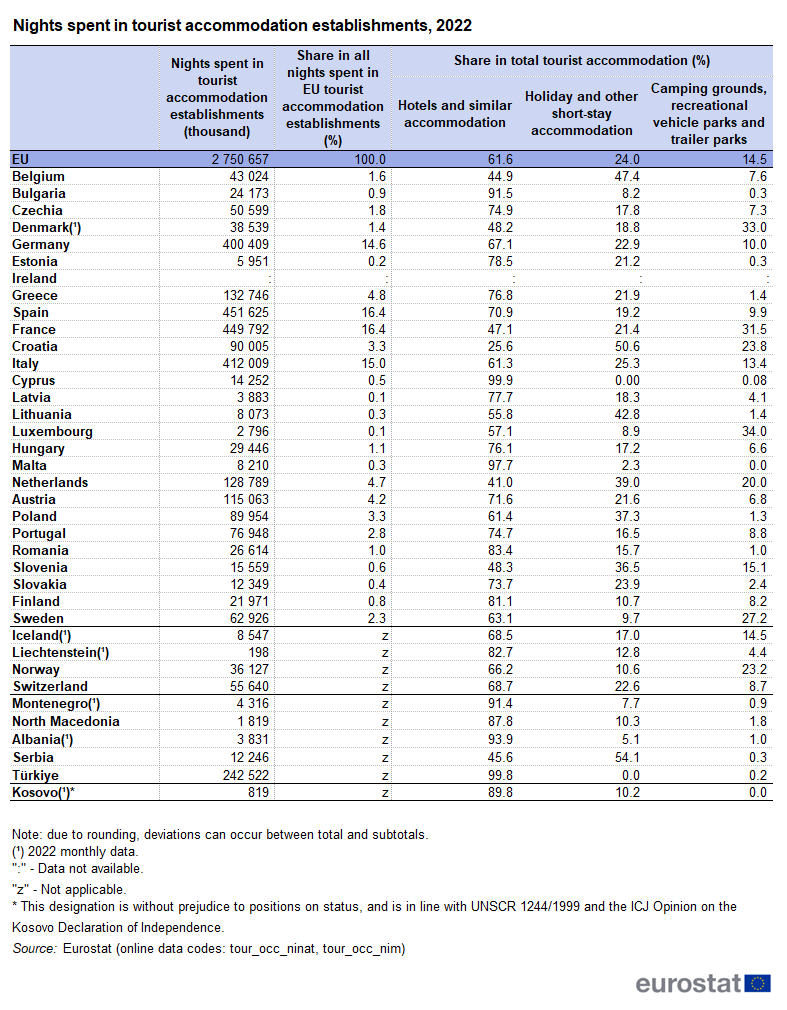
Source: Eurostat (tour_occ_ninat) (tour_occ_nim)
The increase at EU level compared with 2021 reflected positive trends in all EU Member States. Portugal, Greece, Malta, Spain and Austria reported the highest increases of more than 70 % compared with 2021 (see blue bars in Figure 2). Comparing, however, with the pre-Covid-19 figures (see brown bars in Figure 2), Latvia and Slovakia still faced the biggest gap to bridge, reaching less than 75 % of 2019 levels. On the other hand, Denmark (+12.3 %), the Netherlands (+4.3 %), Belgium (+1.2 %) and France (+0.7 %) fully recovered after the Covid-19 pandemic.
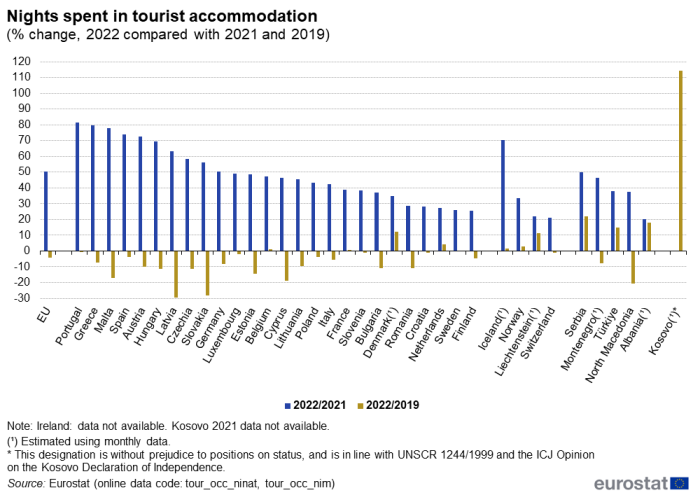
Source: Eurostat (tour_occ_ninat) (tour_occ_nim)
All three types of tourist accommodation showed increases for 2022 compared with 2021. The number of nights spent in hotels increased by 63.2 %, remaining however 8.7 % lower compared with 2019. Nights spent in holiday and other short-stay accommodation and nights spent at campsites increased by 41.2 % and 21.7 % respectively in 2022 compared with 2021, reaching 2019 levels (+0.1 % and +9.9 % respectively) (see Table 2).
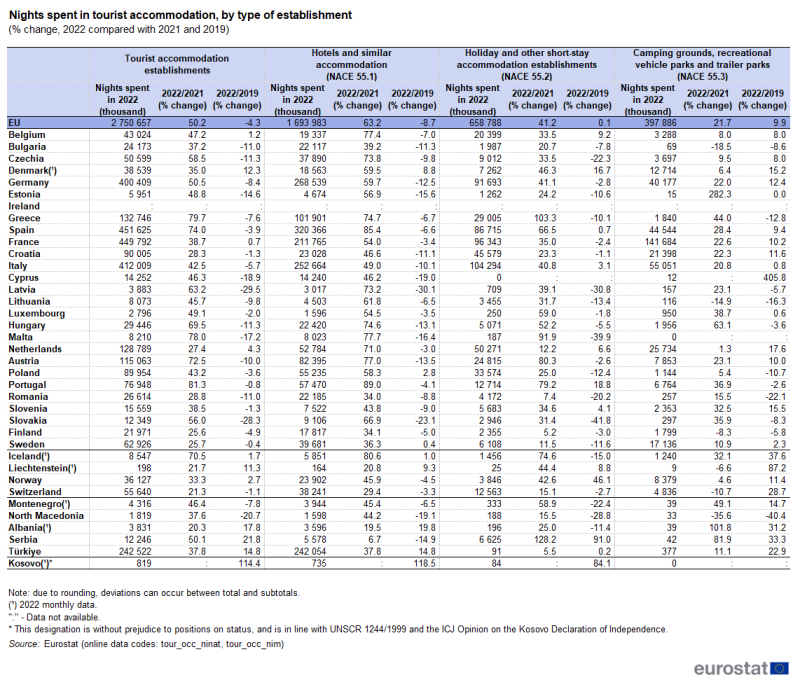
Source: Eurostat (tour_occ_ninat) (tour_occ_nim)
Taking into account the population of the country (tourism intensity), Croatia (with 23.3 nights) and Malta and Cyprus (15.8 nights each) recorded the highest number of nights spent per inhabitant over the year 2022 (see blue bars in Figure 3). In the EU, an average of 6.2 guest nights were recorded in relation to the overall population of 446.7 million in 2022, 0.2 nights less compared with 2019 when tourism intensity at EU level was 6.4 nights spent per inhabitant (see brown dashes in Figure 3).
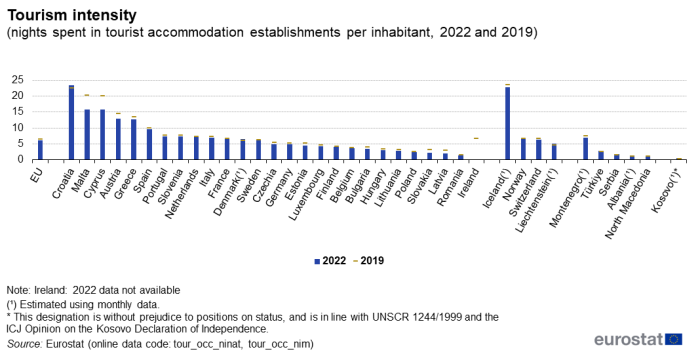
Source: Eurostat (tour_occ_ninat) (tour_occ_nim)
In three EU countries, fewer domestic nights were spent in 2022 than in 2021
The outbreak of the pandemic in March 2020 caused a shift towards domestic tourism. In 2022 compared with 2019, nights spent by international guests fell by 12 %, while nights spent by domestic tourists increased by 2 % (see Table 3). The share of nights spent by international guests in EU tourist accommodation dropped from 47 % in 2019 to 29 % in 2020, while in 2021 this share increased to 32 % of total nights spent and further to 44 % in 2022. Although domestic tourism was less affected, it could only partly compensate for the decline in international tourism.
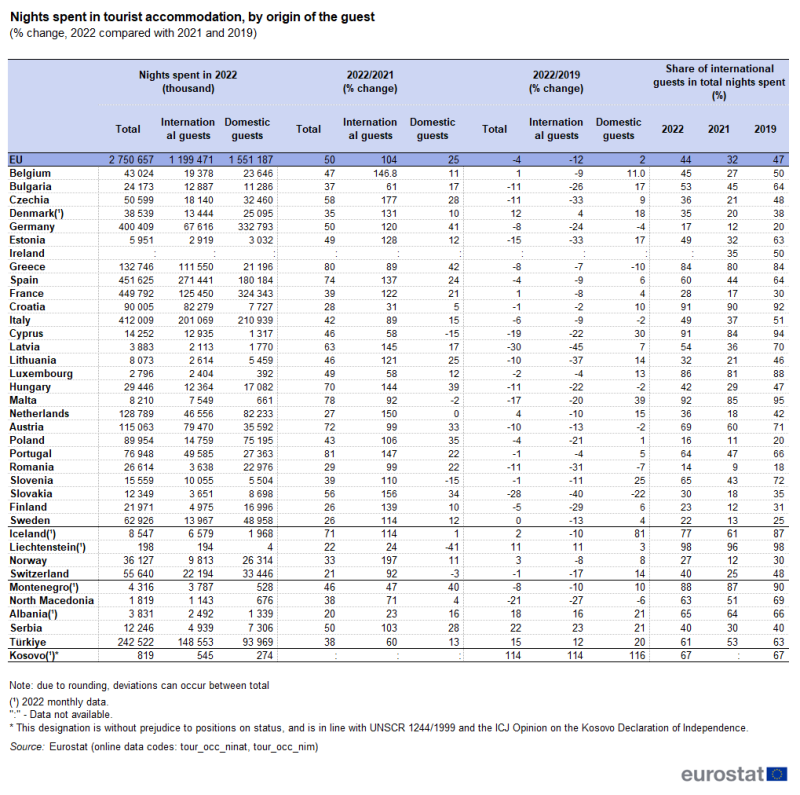
Source: Eurostat (tour_occ_ninat) (tour_occ_nim)
In 2022 compared with 2021, nights spent by international guests in EU tourist accommodation increased by 104 %, reflected in all Member States. The lowest increases, below 60 %, were reported by Croatia, Cyprus and Luxembourg, while in Czechia the overnight stays by international guests almost tripled. Figure 4 shows for each Member State, how close overnight stays by international tourists in 2022 came to 2019 levels, the year before the pandemic. Denmark, Croatia, Portugal and Luxembourg reached over 95 % of 2019 levels, while international tourists in Latvia in 2022 spent less than 60 % of the nights they had spent in 2019.
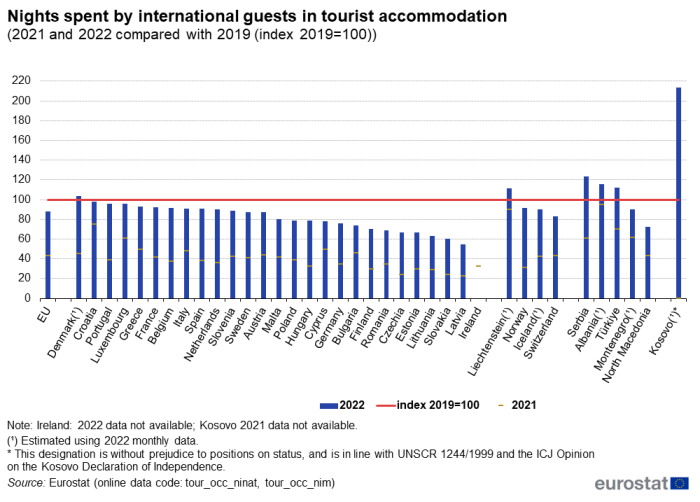
Source: Eurostat (tour_occ_ninat) (tour_occ_nim)
In 2022, 25 % more domestic nights were spent in EU tourist accommodation compared with 2021. Greece (+42 %) and Germany (+41 %) recorded the biggest increases, while Cyprus, Malta and Slovenia reported drops in domestic nights (most likely a substitution effect after a year where it was relatively difficult to travel abroad). Given the fact that domestic tourism recovered faster than international tourism, nights spent by domestic guests in the EU in 2022 reached 2019 levels (+2 %). Figure 5 shows that in 19 EU countries, domestic nights recovered completely in 2022 and even surpassed 2019 levels, while in all other countries domestic nights are much closer to 2019 levels compared with international nights.
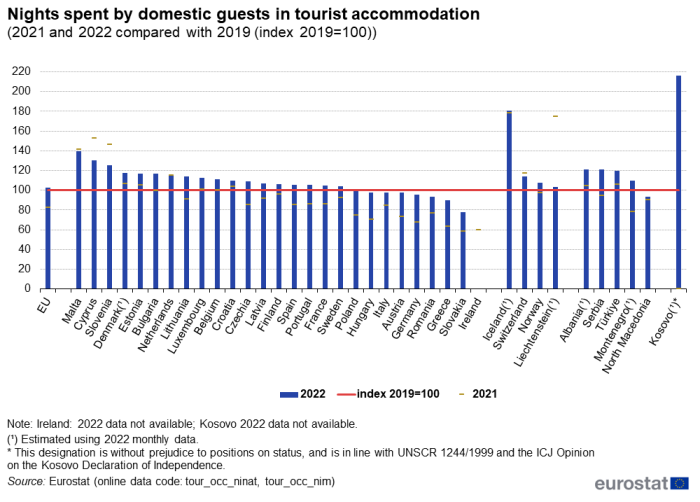
Source: Eurostat (tour_occ_ninat) (tour_occ_nim)
The top 30 NUTS 3 regions represented 26.5 % of all nights spent in the EU
Looking at regional[1] data, the top region at NUTS 3 level attracted 1.8 % of all nights spent in the EU during 2022. This was the Spanish region of Mallorca, followed by the French region of the capital city Paris, the Spanish region of Barcelona and the Italian region of Venezia. In 2022, the top 30 regions accounted for 26.5 % of all nights spent in the 1 166 NUTS 3 regions of the EU, while accounting for only 2.9 % of the EU territory (see Table 4). One in eight tourism nights was spent in the top 10 of the in total 1166 regions, these 10 regions representing only 1.1 % of the EU territory.
Map 1 shows nights spent by international guests as share of total nights spent in each NUTS 3 region. The region of Ausserfern in the Austrian Tirol, the three Greek regions of Irakleio, Lasithi and Rethymno in the island of Crete, and the Croatian region of Istarska županija (Istria County) come on top with 96 % of nights spent by international guests.
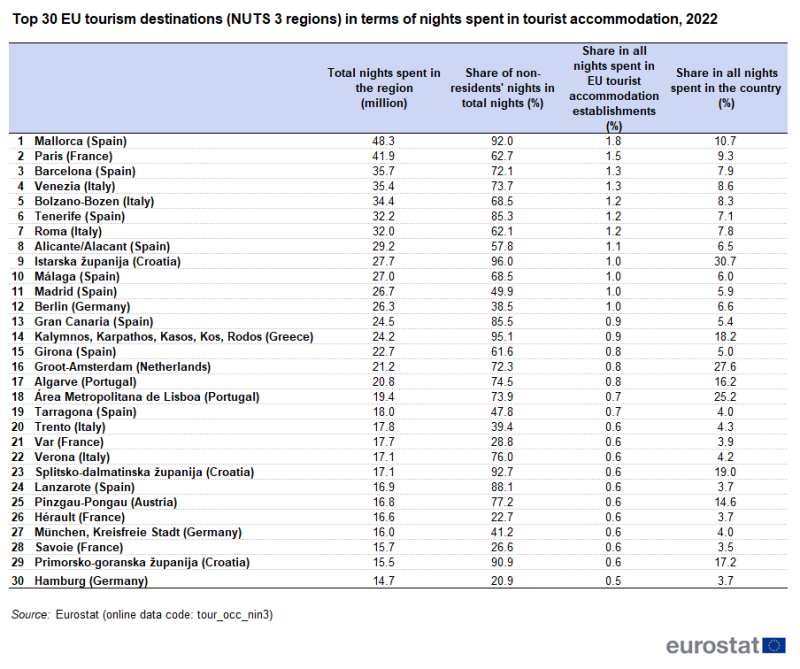
Source: Eurostat (tour_occ_nin3)
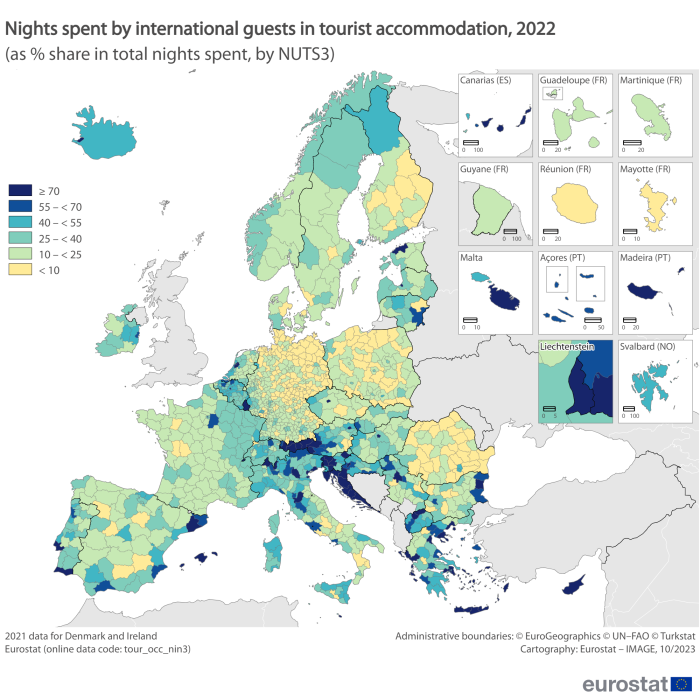
Source: Eurostat (tour_occ_nin3)
Paris, the most visited city in the EU
From 2020 reference year on, Eurostat publishes data on nights spent in selected cities, including all capitals and cities with a minimum population of 200 000 inhabitants as well as some other cities that are of particular importance for tourism. In 2022, more than 71 million nights were spent in Paris, the most visited city in the EU, followed by Roma and Berlin with respectively 29.2 and 26.3 million nights.
Table 5 shows for each country the top 3 cities in terms of nights spent in tourist accommodation. With the exception of Bulgaria, Spain, Croatia and Cyprus the most visited city was the capital city of each Member State. In Latvia, Lithuania and Malta, the capital city accounted for more than half of the total nights spent in the country. Very important shares of the capital cities were also recorded in Estonia (44.5 %), Luxembourg (33.6 %), Hungary (29.6 %), Czechia (26.5 %) and Portugal (22.2 %).

Source: Eurostat (tour_occ_ninc) (tour_occ_nim)
German tourists accounted for nearly four out of every 10 nights spent by international tourists in EU tourist accommodation
In 2022, more than half (56.4 %) of nights in tourist accommodation were spent by domestic tourists, travelling inside their own country (see Figure 6).
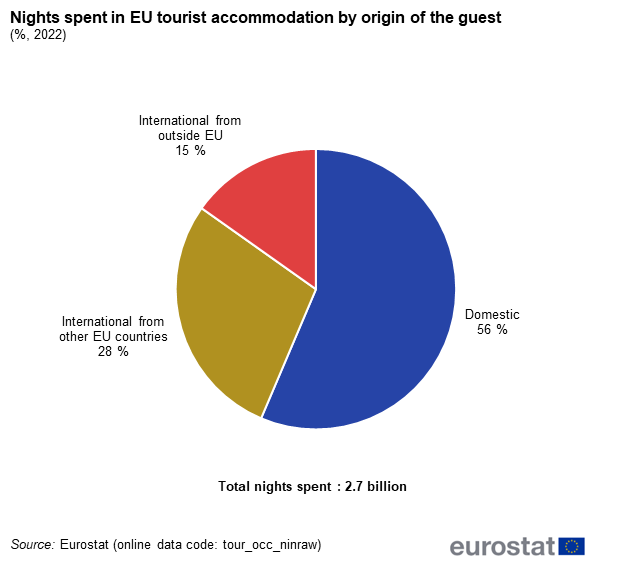
Source: Eurostat (tour_occ_ninraw)
The majority of the 1.2 billion nights spent by international guests were by tourists coming from other EU Member States (65 %), while 22 % were spent by tourists coming from other European countries. Only 13 % of non-resident nights were spent by tourists from other continents (see Figure 7).
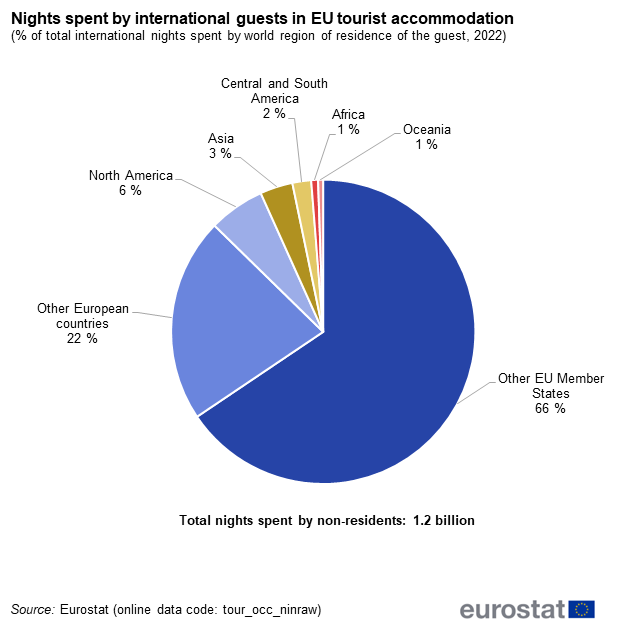
Source: Eurostat (tour_occ_ninraw)
German tourists accounted for 23 % of the total international nights in EU tourist accommodation, followed by French and Italian tourists (with 5.7 % and 3.4 % respectively). For 11 out of the 26 Member States with available data – excluding the German domestic market – the greatest number of tourists came from Germany. For the 13 remaining Member States, nights spent by German tourists were their second or third market, the only exception being Malta (see Table 6).
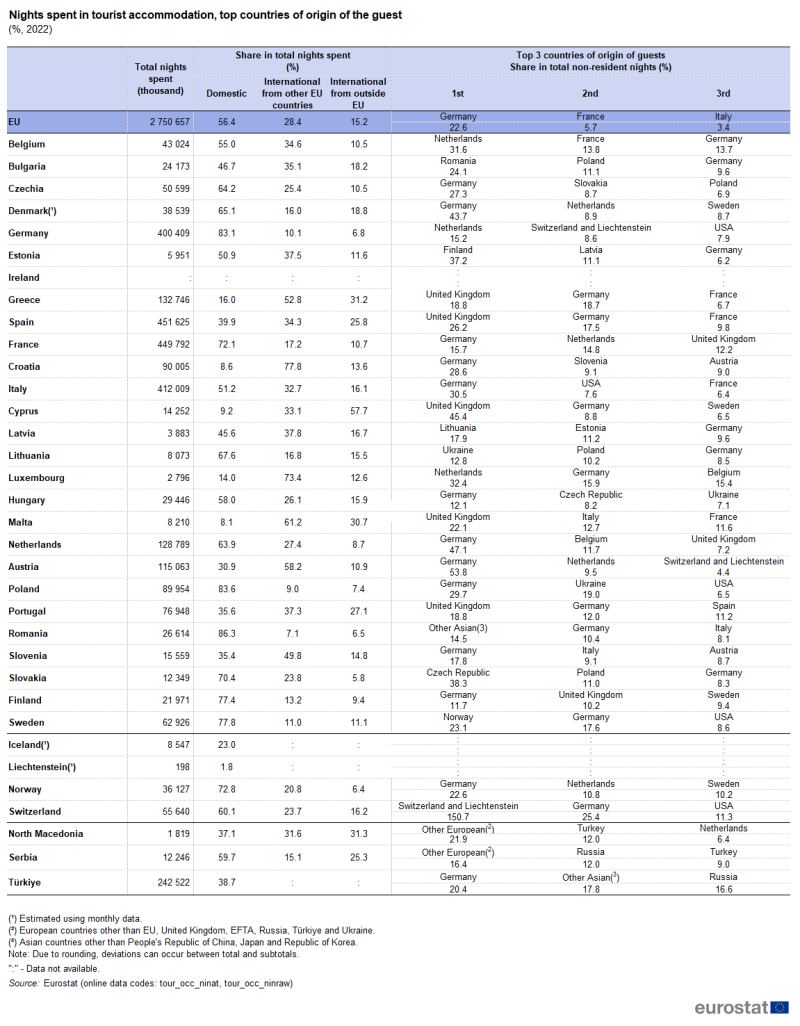
Source: Eurostat (tour_occ_ninat) (tour_occ_ninraw)
More than 28 million bed places in EU tourist accommodation
In 2022, the EU could offer 28.9 million bed places to accommodate tourists, spread over more than 621 000 establishments. In terms of bed places, Italy (with 5.2 million bed places) and France (with 5.1 million bed places) accounted for more than one-third of total available capacity (see Table 7).
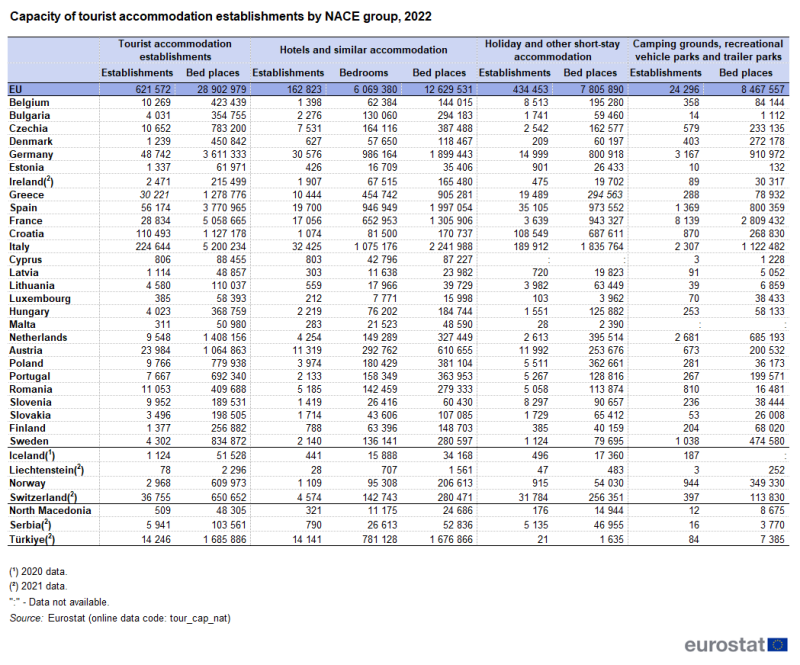
Source: Eurostat (tour_cap_nat)
The comparability and completeness of this data is affected by the fact that countries apply data collection thresholds. In many countries, establishments having fewer than ten bed places are not covered by these statistics, but the threshold applied is not identical across the European Union. This means that the 28.9 million bed places mentioned above is a modest estimate; the actual number of bed places including those offered in the smallest establishments may be higher than the published estimate.
For countries where a breakdown by size class is available, 58 % of hotels and similar accommodation establishments had less than 25 bedrooms, 34 % had between 25 and 99 and 9 % were large establishments with a capacity of 100 or more bedrooms (see Table 8).
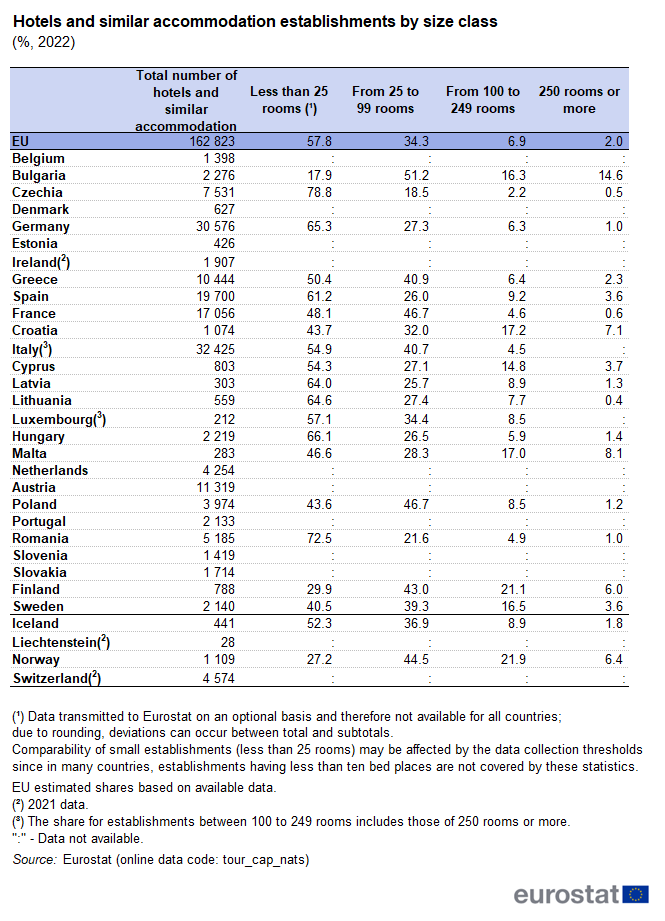
Source: Eurostat (tour_cap_nats)
Average occupancy rate of bed places in hotels was 47 % in 2022
Comparing the capacity data in terms of available beds or rooms with the occupancy data in terms of nights spent gives an indicator of the occupancy rates. At EU level, the net occupancy rate of bed places in hotels was 47 % in 2022, down by 3 percentage points (pp) compared with 2019. The highest occupancy rates were recorded in Cyprus (66 %), Spain (59 %), Croatia (55 %), Malta (54 %) and Greece (51 %) (see Figure 8).
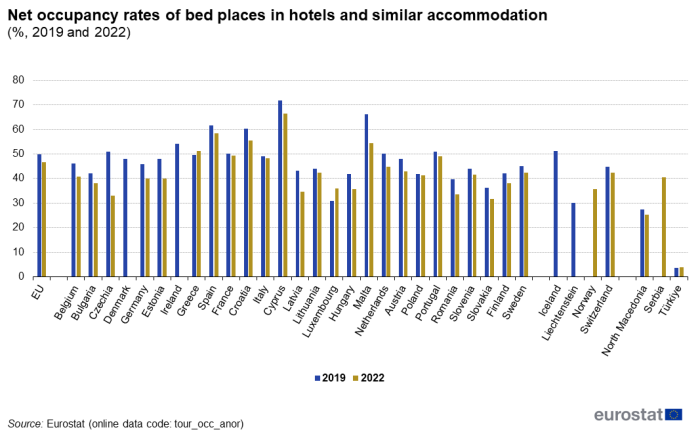
Source: Eurostat (tour_occ_anor)
Source data for tables and graphs
Data sources
For the short-term trends in the nights spent at tourist accommodation establishments in the European Union (EU), see the quarterly updated article Tourism statistics - nights spent at tourist accommodation establishments.
Context
The EU is a major tourist destination, with four Member States among the world's top ten destinations for holidaymakers, according to UNWTO[2] data. Tourism is an important activity in the EU which contributes to employment and economic growth, as well as to the development of rural, peripheral or less-developed areas. These characteristics drive the demand for reliable and harmonised statistics on this activity, as well as within the wider context of regional policy and sustainable development policy areas.
Direct access to
- Tourism (t_tour)
- Capacity and occupancy of tourist accommodation establishments (ESMS metadata file — tour_occ_esms)
- With 2012 as reference year:
- Regulation (EU) No 692/2011 of 6 July 2011 concerning European statistics on tourism and repealing Council Directive 95/57/EC. (Summary)
- Regulation (EU) No 1051/2011 of 20 October 2011 implementing Regulation (EU) No 692/2011 concerning European statistics on tourism, as regards the structure of the quality reports and the transmission of the data.
- Previous legal acts (concerning reference periods before 2012):
- Commission Decision 1999/35/CE of 9 December 1998 on the procedures for implementing Council Directive 95/57/EC on the collection of statistical information in the field of tourism.
- Commission Decision 2004/883/CE of 10 December 2004 adjusting the Annex to Council Directive 95/57/EC on the collection of statistical information in the field of tourism as regards country lists.
- Directive 95/57/EC of 23 November 1995 on the collection of statistical information in the field of tourism.
- Directive 2006/110/EC of 20 November 2006 adapting Directives 95/57/EC and 2001/109/EC in the field of statistics, by reason of the accession of Bulgaria and Romania.
- Regional Statistics Illustrated - select statistical domain 'Tourism' (top right)
- Agenda for a sustainable and competitive European tourism (Communication from the European Commission, October 2007)
- European Commission - Directorate-General for Internal Market, Industry, Entrepreneurship and SMEs - Tourism
Notes
- ↑ More detailed regional data: Tourism statistics at regional level
- ↑ UNWTO data
